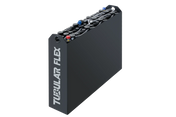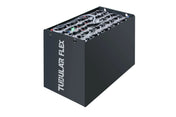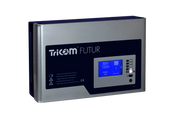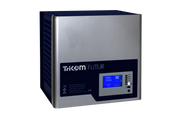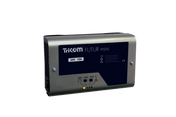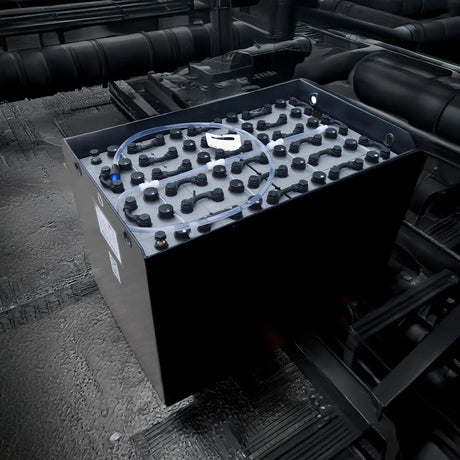Anyone transporting forklift batteries must comply with certain legal requirements – especially if they are classified as hazardous goods.
To ensure everything is safe and legally compliant, proper packaging, labeling, and documentation are essential. In this article, you'll learn what to look out for when shipping and how to avoid common mistakes.
Why forklift batteries are considered dangerous goods
Which battery types are affected
Lead-acid batteries are typically used in forklifts. These contain sulfuric acid and lead – substances with a high potential for danger in the event of a short circuit, acid leakage, or damage. Lithium-ion batteries are also subject to hazardous goods regulations.
Definition according to ADR and GGVSEB
Forklift batteries are generally classified as dangerous goods according to ADR (European Agreement concerning the International Carriage of Dangerous Goods by Road) and the national GGVSEB ( German Transport and Handling Regulations). An exception is the transport of used or defective batteries for disposal , provided they fall under special provision 598, paragraph 2 of the ADR . In this case, simplified requirements apply – for example, for scrap batteries in suitable containers.
Legal basis for the transport of forklift batteries
Dangerous goods law (ADR, UN numbers, classification)
Forklift batteries are clearly classified as dangerous goods by the corresponding UN number (e.g., UN 2794 for wet lead-acid batteries or UN 3480 for lithium-ion batteries). This UN number must be indicated on the shipping document and on the labeling.
Responsibility of senders and carriers
Shippers are responsible for proper packaging, labeling, documentation, and training. Transport service providers must ensure that transport is carried out in accordance with regulations.
Obligations according to GHS and CLP Regulation
Dangerous goods are also subject to GHS/CLP labeling . This particularly applies to hazard pictograms and safety information for substances such as sulfuric acid or lithium compounds.
Packaging and labeling: This is mandatory
Specifications for new and used batteries
Even used or repaired batteries must be fully packaged and protected against short circuits, leakage or tipping over.
Marking with UN numbers, hazard labels and symbols
Each packaging unit requires clearly visible hazard labels and the appropriate UN number , affixed on at least two sides.
Packaging groups and suitable transport containers
Depending on the hazardous goods class , acid-resistant plastic crates or ADR-certified transport containers are required. For collective transport, wire mesh crates with suitable inner lining can also be used.
Means of transport and security: How to do it right
Requirements for trucks, containers and loading areas
Vehicles must have a stable loading floor and be properly secured against slipping – e.g., with anti-slip mats and tensioning straps.
Protection against tipping over, leakage and short circuit
Batteries must be mechanically fixed , poles must be covered, and escaping electrolyte must be able to be collected by trays or absorber materials.
Temperature and weather protection
The recommended transport temperature is between –20 °C and +45 °C . Avoid direct sunlight, frost, or moisture.
Special features when shipping used or damaged batteries
Difference to brand new batteries
When transporting used batteries, regardless of their condition, stricter packaging and documentation requirements apply. Professionally tested and reconditioned batteries, such as those offered by certified dealers like HK Handels GmbH, reliably meet these requirements.
Additional security measures
Before transport, an assessment of the hazard potential is necessary – e.g., by visual inspection, voltage measurement or acid level check.
Transport ban for certain types of damage
Batteries that are severely damaged – e.g. if electrolyte has leaked, cells have burst, or there is a risk of a short circuit – must not be transported .
Documentation and proof requirements
Transport documents, safety data sheets, etc.
Required are, among other things: dangerous goods transport documents , safety data sheets (SDS) , UN approvals or manufacturer declarations if applicable.
Control obligations upon handover and receipt
Transport managers document the loading status, container condition, and handover time. Checklists help record all requirements.
Checklist for preparing for shipping
- Record battery type and condition
- Determine UN number and dangerous goods class
- Select suitable packaging
- Attach dangerous goods labels
- Provide documents
- Check load securing
- Ensure training for staff
Recommendations for companies: How to minimize risks
Training obligations for employees
Persons involved in shipping or transport require regular training in accordance with ADR – with documented proof.
Cooperation with certified dangerous goods forwarding companies
Reliable freight forwarders offer ADR-compliant transport including packaging, labeling and documentation.
Avoiding common mistakes in everyday life
Typical errors such as missing labeling, incorrect packaging or incomplete documentation can be avoided through standardized processes and clear responsibilities .
Conclusion
Transporting forklift batteries as hazardous goods requires expertise , clear processes , and legally compliant implementation . Properly packaging, labeling, and documenting batteries protects not only the environment and employees, but also your own company.
Compliance with all regulations is especially important when shipping used batteries . Trust certified specialist retailers like HK Handels GmbH – here you'll receive tested quality, transparent processes , and expert advice on transport, storage, and reuse.


